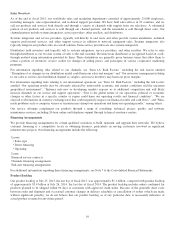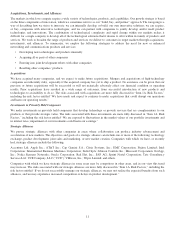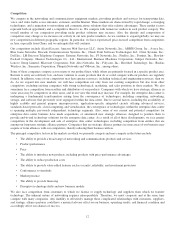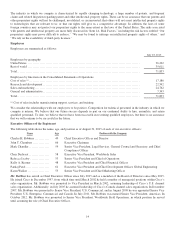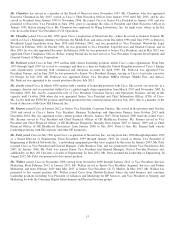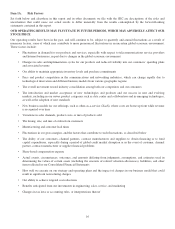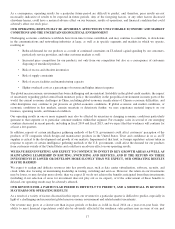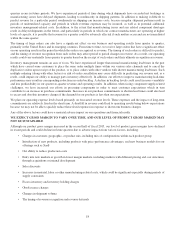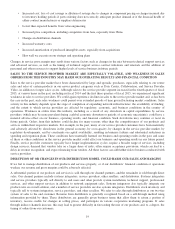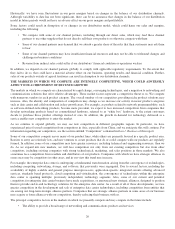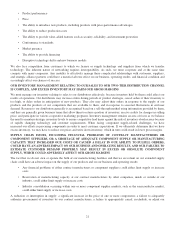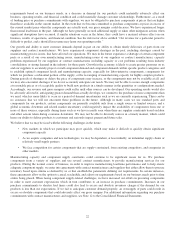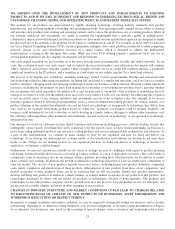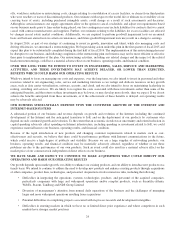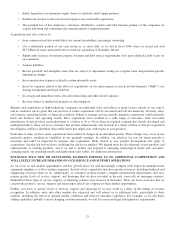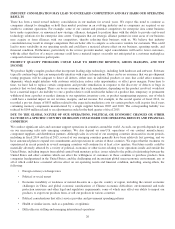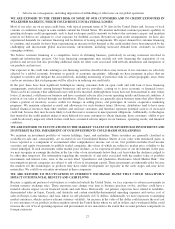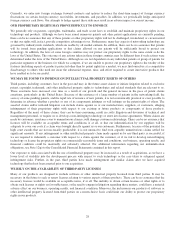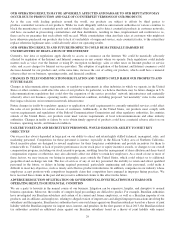Cisco 2015 Annual Report Download - page 27
Download and view the complete annual report
Please find page 27 of the 2015 Cisco annual report below. You can navigate through the pages in the report by either clicking on the pages listed below, or by using the keyword search tool below to find specific information within the annual report.• Increased cost, loss of cost savings or dilution of savings due to changes in component pricing or charges incurred due
to inventory holding periods if parts ordering does not correctly anticipate product demand or if the financial health of
either contract manufacturers or suppliers deteriorates
• Lower than expected benefits from value engineering
• Increased price competition, including competitors from Asia, especially from China
• Changes in distribution channels
• Increased warranty costs
• Increased amortization of purchased intangible assets, especially from acquisitions
• How well we execute on our strategy and operating plans
Changes in service gross margin may result from various factors such as changes in the mix between technical support services
and advanced services, as well as the timing of technical support service contract initiations and renewals and the addition of
personnel and other resources to support higher levels of service business in future periods.
SALES TO THE SERVICE PROVIDER MARKET ARE ESPECIALLY VOLATILE, AND WEAKNESS IN SALES
ORDERS FROM THIS INDUSTRY MAY HARM OUR OPERATING RESULTS AND FINANCIAL CONDITION
Sales to the service provider market have been characterized by large and sporadic purchases, especially relating to our router
sales and sales of certain products in our newer product categories such as Data Center, Collaboration, and Service Provider
Video, in addition to longer sales cycles. Although sales to the service provide segment increased in the fourth quarter of fiscal
2015, at various times in the past, including in fiscal 2014 and the first three quarters of fiscal 2015, we experienced significant
weakness in sales to service providers. We could again experience declines in sales to the service provide market and, as has been
the case in the past, such sales weakness could persist over extended periods of time given fluctuating market conditions. Sales
activity in this industry depends upon the stage of completion of expanding network infrastructures; the availability of funding;
and the extent to which service providers are affected by regulatory, economic, and business conditions in the country of
operations. Weakness in orders from this industry, including as a result of any slowdown in capital expenditures by service
providers (which may be more prevalent during a global economic downturn or periods of economic uncertainty), could have a
material adverse effect on our business, operating results, and financial condition. Such slowdowns may continue or recur in
future periods. Orders from this industry could decline for many reasons other than the competitiveness of our products and
services within their respective markets. For example, in the past, many of our service provider customers have been materially
and adversely affected by slowdowns in the general economy, by overcapacity, by changes in the service provider market, by
regulatory developments, and by constraints on capital availability, resulting in business failures and substantial reductions in
spending and expansion plans. These conditions have materially harmed our business and operating results in the past, and some
of these or other conditions in the service provider market could affect our business and operating results in any future period.
Finally, service provider customers typically have longer implementation cycles; require a broader range of services, including
design services; demand that vendors take on a larger share of risks; often require acceptance provisions, which can lead to a
delay in revenue recognition; and expect financing from vendors. All these factors can add further risk to business conducted with
service providers.
DISRUPTION OF OR CHANGES IN OUR DISTRIBUTION MODEL COULD HARM OUR SALES AND MARGINS
If we fail to manage distribution of our products and services properly, or if our distributors’ financial condition or operations
weaken, our revenue and gross margins could be adversely affected.
A substantial portion of our products and services is sold through our channel partners, and the remainder is sold through direct
sales. Our channel partners include systems integrators, service providers, other resellers, and distributors. Systems integrators
and service providers typically sell directly to end users and often provide system installation, technical support, professional
services, and other support services in addition to network equipment sales. Systems integrators also typically integrate our
products into an overall solution, and a number of service providers are also systems integrators. Distributors stock inventory and
typically sell to systems integrators, service providers, and other resellers. We refer to sales through distributors as our two-tier
system of sales to the end customer. Revenue from distributors is generally recognized based on a sell-through method using
information provided by them. These distributors are generally given business terms that allow them to return a portion of
inventory, receive credits for changes in selling prices, and participate in various cooperative marketing programs. If sales
through indirect channels increase, this may lead to greater difficulty in forecasting the mix of our products and, to a degree, the
timing of orders from our customers.
19



